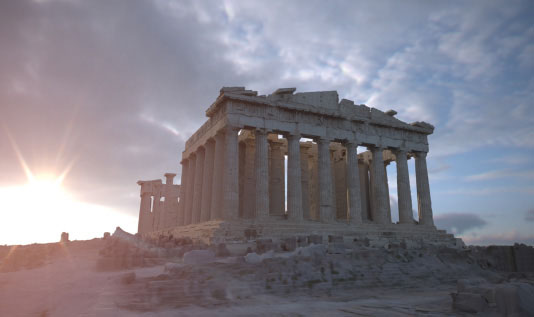“The Parthenon” by Debevec
Conference:
- SIGGRAPH 2004 More animation videos from SIGGRAPH 2004:


Title:
- The Parthenon
Length:
- 8:01
Director(s):
Company / Institution / Agency:
- University of Southern California
Description:
This animation uses new computer graphics research to present a visualization of the Parthenon and its sculptures. The sculptures are shown in their current location in the British Museum, as well as where they were originally placed on the Parthenon. The film begins with models of the Parthenon’s frieze, metopes, and pediment sculp- tures. These sculptures were scanned from high-quality casts in the Skulpturhalle Basel using a custom-structured light 3D scanning system. A Christian column carving and a Turkish-era cannonball impact were recorded on-site using a photometric stereo technique. Using high-dynamic-range time-lapse illumination, a complete day of light is simulated on a 90-million-polygon model of the Parthenon obtained through laser scanning the structure with a Quantapoint time-of-flight laser range scanner. Fifty-three panoramic scans were assembled using the MeshAlign 2.0 software from CNR Pisa and post-processed using GSI’s GSI Studio software. New inverse global illumination reflectometry techniques were used to recover lighting-independent texture maps for the Parthenon, and renderings were created using Monte Carlo-based global illumination. The time-lapse image-based lighting was chosen from one of several days recorded in Marina del Rey, California using a new HDR capture process. Rendering this sequence virtually allowed us to show the Parthenon without scaffolding and tourists, and to design the camera moves and lighting in postproduction. The sequence ends with a sunset seen from a virtual reconstruction of the Erechtheion featuring scanned models of the Caryatid figures.
The sculptures were transported from Athens to London by Lord Elgin in the early 1800s. To show the sculpture’s current location, a 3D model of the Parthenon Gallery in the British Museum was created using the Façade photogrammetric modeling system. Details were added using traditional modeling in Maya. Texture maps were created from “unlit” digital photographs, with absolute color and reflectance values determined using a color reference chart to correctly simulate indirect light within the museum. Photographs of the real sculptures in the museum were projected onto the geometry scanned from the cast collection to produce the virtual models seen in the museum. Because we did not have a useful model of the torso of Poseidon, the final shot in the museum sequence was accomplished through a new combination of silhouette-based reconstruction and view inter- polation. High-dynamic-range lighting and image-based rendering were used to create the virtual camera moves in the museum. The film’s final sequence uses all of these techniques together to perform several cross-dissolves between the sculptures in the museum and the locations they once occupied on the Parthenon. In one tran- sition, the polychromy of the frieze is restored to a conjectured painted coloration based on archaeological reconstructions, and the Parthenon is seen as it stood on the ancient Acropolis.
The entire film was rendered in high dynamic range using the Arnold renderer, a Monte Carlo-based global illumination system.
Hardware:
HARDWARE: PC Intel 2.4 GHz CPU, 2 GB RAM. Rendering farm: 37 CPUs.
Software:
SOFTWARE DEVELOPER: Modeling: Maya 5, Facade 1.0, MeshAlign 2.0, GSI Studio. Animation: Maya 5. Rendering: Arnold 2.0. Compositing: HDR Shop 2.0, Additional software: Adobe Premiere Pro, Adobe After Effects 6.0. Custom soft- ware: The Facade photogrammetric modeling system, the Arnold renderer (Global Illumination), HDR Shop (HDR image editing), ZIGI Inverse Global Illumination system to derive the Parthenon’s reflectance properties. OS: Windows 2000, RedHat Linux.
Additional Contributors:
Producers: Diane Piepol, Lora Chen, Maya Martinez
Contributors: Paul Debevec, Brian Emerson, Marc Brownlow, Per Einarsson, Marcos Fajardo, Andrew Gardner, Tim Hawkins, Andrew Jones, Therese Lundgren, Philippe Martinez, Charis Poullis, John Shipley, Jessi Stumpfel, Chris Tchou, Andreas Wenger, Nathaniel Yun
Additional Information:
PRODUCTION Modeling: Laser scanning, photogrammetry. Rendering technique used most: Monte Carlo Global Illumination. Average CPU time for rendering per frame: one hour (on a dual 2.4 GHz Pentium IV). Total production time: 58 days. Production highlight: The Parthenon model was built from 53 panoramic laser scans taken over five days in Athens, with textures derived from digital photographs and a custom inverse global-illumination algorithm. The sculptures were scanned using a custom-structured light scanner from plaster casts in the Skulpturehalle Basel and texture-mapped with digital photographs of the originals in the British Museum. The British Museum was modeled in Maya, making use of photogrammetric measurements from the Façade modeling system.
Music: “Mozart: Great Mass in C Minor K. 427 ‘Kyrie.’” Performed by Berliner Philharmoniker/Herbert Von Karajan. Courtesy of Deutsche Grammophon under license from Universal Music Enterprises.




